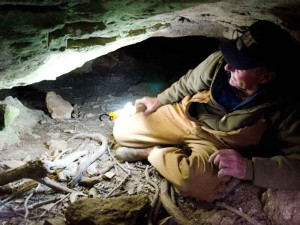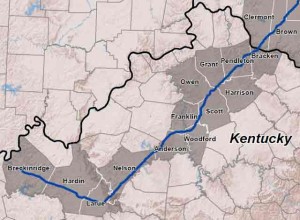A new pipeline from PA fracking fields stirs controversy in the Bluegrass State
By NATASHA KHAN
PublicSource / Special to the NC Gazette
Sunday, Dec. 22, 2013 — (STAMPING GROUND) — The land agent first came knocking on Vivian and Dean House’s door in July. They sat on the patio of the retired couple’s 85-acre farm in this Central Kentucky town and chatted.

Nolen Boone’s family has owned his 120-acre farm in New Haven for generations. Boone crawls around a cave that spiders for a mile under his property and that of two of his neighbors. Click image to enlarge. (Photo by Natasha Khan / PublicSource)
The guy was friendly, the kind of guy Dean could talk to about fishing.
He put the couple at ease and told them his company was interested in running a pipeline through their land. They were later offered more than $165,000 to sign easements.
“My husband, Dean, he told them that he didn’t want ‘em messing up his alfalfa field … and didn’t want big machinery coming in and messing up the farm,” Vivian said about their land, where they raise cattle and grow alfalfa.
They were assured that wouldn’t happen.
They let the company survey for a section of the proposed 1,100-mile Bluegrass Pipeline. It would transport natural gas liquids from fracking in Pennsylvania, Ohio and West Virginia to petrochemical markets in Louisiana.
In late October, Vivian House pointed to areas where the pipeline developers surveyed her 85-acre cattle and hay farm for the proposed Bluegrass Pipeline. (Photo by Natasha Khan / PublicSource)
Men mapped out where the pipeline could cut through the House’s property. They tied hot pink ribbons to fences and stuck thick wooden stakes in the ground.
But Vivian started having doubts when she learned it wasn’t a regular natural gas line, but one that would carry flammable liquid byproducts of natural gas.
She worried that their land, naturally riddled with sinkholes and streams, could be contaminated by leaks.
“We are cattle and hay farmers,” she said. “And if it kills our cattle, we’re just gone.”
A project that pits big energy companies against farmers and environmentalists is causing quite a stir in the land of Thoroughbreds and Bourbon.
“They are really enthusiastic about it in other states, but not so much in Kentucky,” Scott Carney, a spokesman for the Bluegrass Pipeline, said in early November.
Some Kentucky landowners told PublicSource they don’t want the pressurized 24-inch diameter underground pipeline coming through their farms because of concerns about public safety, potential destruction of property and environmental harm. Others said they see no public benefit to Kentuckians from a pipeline transporting liquids from the Northeast to make plastics in Louisiana or to export.

Map of the proposed route of the Bluegrass Pipeline. Click to enlarge.
The project is a joint venture between two big pipeline companies, Williams Co. and Boardwalk Pipeline Partners. By 2015, the companies want the pipeline up and running, pushing up to 400,000 barrels of natural gas liquids per day.
Natural gas liquids from the shale boom, such as propane, butane and ethylene, are being used to make things like plastic bags and detergents.
The shale revolution has brought increased concerns about pipeline safety. The Bluegrass Pipeline is just one of five proposed pipelines that will move the glut of natural gas liquids from the Marcellus and Utica shale regions in the Northeast.
Pipeline officials assure Kentuckians the Bluegrass Pipeline will be constructed and maintained safely. It will bring jobs to the region, add millions in local tax revenues and contribute to America’s energy independence, they said.
Some concerned Kentucky landowners have turned down big paydays.
After Penny Greathouse refused a $350,000 easement offer, the pipeline officials came back with a $658,000 offer, she said. She turned it down.
“My life and livelihood and health mean a lot more to me than money,” said Greathouse as she leaned against her Ford pickup on the 700-acre cattle farm her family owns in Stamping Ground.
People like Greathouse are organizing grassroots efforts against the pipeline. They’ve held protests in the state capital, knocked on neighbors’ doors and started websites and Facebook pages.
“No Pipeline” and “Stop the Bluegrass Pipeline” signs are plastered to fences along dusty roads.
The proposed pipeline would pass through eight states. New construction of around 500 miles would start in two places, Mercer County, Pa. and Marshall County, W. Va., cut through a big chunk of Ohio and 13 counties in Kentucky and meet up with an existing pipeline in Breckinridge County, Ky., that goes to Louisiana.
Despite the opposition, the pipeline developers seem to be making progress. They’ve signed more than 50 percent of the easements needed in Kentucky as of early December and are more than 40 percent complete along the entire route, according to Carney.
‘We don’t want it’
 Nolen Boone crawls across jagged pieces of crumbly, brownish-green rock and broken whiskey bottles. He works his way into the mouth of a mile-long cave that tunnels underneath his 120-acre farm in Nelson County.
Nolen Boone crawls across jagged pieces of crumbly, brownish-green rock and broken whiskey bottles. He works his way into the mouth of a mile-long cave that tunnels underneath his 120-acre farm in Nelson County.
The 63-year-old construction worker and cattle farmer lies on his side in the cramped cave, about the height of a healthy 3-year-old.
Boone holds up a portable plastic stick light, illuminating a network of caves that stretch like veins under much of the land in this part of Kentucky.
“That pipeline has got to come across this cave at some point in time if they come the way they got it marked,” Boone says, tucking his hair into a faded blue CAT tractor hat.
Boone is lying on karst, rock prone to the formation of caves and sinkholes. It’s estimated to cover as much as 50 to 65 percent of Kentucky, according to Chuck Taylor, a hydrogeologist with the Kentucky Geological Survey.
While geologists don’t know exactly how many miles of karst the pipeline would go through, landowners worry about it tunnelling through karst regions made up of soft rocks like limestone, dolomite and gypsum. Some Kentuckians claim that it’s the limestone-rich soil that gives bluegrass a high calcium content, which makes the bones of Thoroughbreds strong.
“This is serious business and we have a very serious focus on safety,” said Carney, the Bluegrass Pipeline spokesman. “This thing will be designed in a manner that is going to minimize potential risk with karst.”
But a pipeline of this size is complicated, said Richard Kuprewicz, president of Accufacts, a pipeline consulting firm.
“You’ve got to be nuts to put a large diameter HVL in a karst terrain,” said Kuprewicz of the highly volatile liquids pipeline. “You can have the best, strongest pipe in the world, but you put it in a bad route, it could snap the pipeline.”
Because the rock is porous, karst can affect the stability of the pipeline, said Ralph Ewers, a hydrogeologist who specializes in karst issues.
If a leak occurs in the porous rock, there’s the possibility of groundwater contamination because of the vast underground streams in Kentucky karst, he said.
Chemicals that make up natural gas liquids could vaporize and settle in caves, increasing the risk of explosion, according to Ewers.
But if the developers design the proper safeguards, the pipeline can be built and maintained safely, said Taylor, of the state geological group.
On Boone’s 120-acre farm, he points to a natural stream his cows drink from year-round. It goes right through the route mapped by a right-of-way crew for the pipeline.
Boone’s land, in his family since 1940, is a stunning roller coaster of green hills, spotted with cows and streams. It neighbors more than 2,000 acres of farmland owned by the Abbey of Gethsemani, once the home of famed Trappist monk, Thomas Merton. The current monks have said they do not want the pipeline on their property.
And the Sisters of Loretto, Catholic nuns in nearby Marion County, first brought public attention to the pipeline when they refused to allow the company to tunnel through their 800-acre farm.
You can tell Boone loves his land, but he is reluctant to talk about it because everyone “spills that story out,” he said.
He’s decided he doesn’t want the pipeline on his land or anywhere in Kentucky.
These companies are “going to make millions and millions of dollars and the landowners are going to pay the consequences if it blows up or leaks,” he said.
“It can’t be a good thing for us,” Boone said. “We don’t want it in this part of the country.”
A heated public forum
Stamping Ground is named for the great herds of bison that once roamed the land.
It’s rural Kentucky. There are no stoplights here.
In late October, a group of more than 100 attended a Scott County meeting with several pipeline officials.
“We’re here to provide answers,” said Bill Lawson, the Williams Co. director of corporate development.
The sometimes heated meeting lasted for hours and the line for the microphone was often 10 deep. At one point, an angry Scott County landowner got kicked out of the meeting for causing a ruckus.
Around 30 local construction workers in bright orange shirts were there in support of the project because of potential jobs.
“It’s a good thing for our community,” said Holly Isaacs, who works for a local union in Lexington. “We’re here to support the fact that they’ll use skilled, trained labor.”
The company projects 1,500 temporary jobs and about 30 permanent jobs will be created in Kentucky during construction. The officials also said they plan to dish out $30 million to $50 million in easement payments in the state.
As for safety, they explain, the Bluegrass Pipeline will have features including state-of-the-art 24/7, 365-day surveillance from a control center, on-ground and aerial inspections and shut-off valves every eight to 10 miles.
“These are not the pipelines of yesteryear; these are incredibly well-designed, well-thought-out pieces of infrastructure,” said pipeline spokesman Jay Vincent.
People asked about Williams’ safety record in light of three recent incidents at Williams-owned pipelines and factories:
● In June, there was an explosion at the Williams Olefins’ plant, an ethane cracker in Geismar, La. Two workers were killed and more than 100 people were injured. There is an ongoing federal investigation.
● In December 2012, more than 10,000 gallons of natural gas liquids leaked in Parachute, Colo. from a Williams-owned pipeline. It leaked, contaminating soil and groundwater, for more than two weeks before it was discovered.
● In September 2008, part of the Williams-owned Transco pipeline in Appomattox County, Va., which stretches from New York to the Gulf of Mexico, ruptured. An explosion from a natural gas pipeline destroyed two homes and caused several injuries. Williams was fined $952,000 for failing to repair a corroded part of the 53-year-old pipeline.
Carney said out of the thousands of miles of pipeline his company operates, leaks and explosions are rare.
Eminent domain

TOM FITZGERALD
Tom FitzGerald, the feisty director of the Kentucky Resources Council, an environmental advocacy and legal group, asked whether Williams would use eminent domain to grab land from unwilling farmers. Eminent domain — the right to take someone’s property for a public use — has quickly become one of the hottest issues in the pipeline debate.
Lawson called it a last resort and said the company has no intention of using it. The company would have to file for the right to invoke eminent domain in court.
A group of Kentucky landowners, including farmer Greathouse, filed a lawsuit in Franklin County Circuit Court in December. They asked the court to clarify whether eminent domain could be used by the company if landowners refuse to sign easements.
Carney, the Williams spokesman, declined to comment on the litigation.
At issue is whether the pipeline is being used for the public good, a qualification to invoke eminent domain under state law. It is normally used for things such as highways and power lines.
The head of Kentucky’s Energy and Environment Cabinet and the Attorney General said the company doesn’t have the right to condemn a person’s land.
But just the threat of using eminent domain can have an effect on whether someone decides to sign an easement, FitzGerald said. Landowners might sign because of fears they’d be taken to court, he said.
FitzGerald is known as the watchdog for environmental issues in Kentucky.
He said pipeline operators moving natural gas liquids take advantage of federal regulatory loopholes that allow them to avoid a complete environmental impact study, which a regular natural gas pipeline would be subject to.
“There is no gatekeeper that is looking at this and saying this project is necessary and this project makes the most sense,” he said.
FitzGerald and others in Kentucky are calling on the Federal Energy Regulatory Commission and the U.S. Army Corp of Engineers to conduct a complete environmental impact study to determine whether the proposed route for the pipeline is the safest.
Knocking on doors
The Houses have rescinded permission for the pipeline company to survey their land.
Since the pleasant conversation with the land agent who knocked at her door, Vivian House has gone door to door to inform neighbors of a pipeline she calls a bad deal. She worried about how a pipeline disaster could affect the nearly 600 residents in her city, a poor cousin to some of its richer nearby towns.
Vivian fears that some of her neighbors might not be able to say no to a big payday.
“I cannot in good faith tell any of my neighbors not to take an offer,” she said.
“Can I turn it down?
“Yes, I can.”
Reach Natasha Khan at 412-315-0261 or nkhan@publicsource.org.






